Five Tips For Alaska Steelheaders

STORY AND PHOTOS BY TONY ENSALACO
While making the 100-mile return trip home from an early winter steelhead excursion, my buddy Ricky Dunnett and I were finally able to engage in a healthy, two-way conversation. This was more significant talk than the mumbling, short phrases like “Missed ’im” and “There’s one” that we had been reiterating for the previous nine hours.
The potent coffee from the gas station must have stimulated our weary brains, which allowed us to start speaking in more complex sentences again.
About halfway into the ride, Ricky brought up the topic of past fishing acquaintances and, more specifically, who were the best steelheaders that I know, and what made them so good? A few names came to me very quickly.
I have been fortunate to have fished with some of the most talented anglers on the planet – guys who can consistently pull a limit of fish out of a 10-gallon bucket during a severe cold front. As we sorted through the list, I realized that they shared some common qualities with one another.
When I got home later that night, I couldn’t stop thinking about what Ricky and I had discussed earlier that evening. Maybe it was the residual effect of the coffee I’d consumed, but I felt compelled to call a few of my buddies. This way I could ask them who they thought should be enshrined on the Mount Rushmore of steelheaders and what attributes separate them from the rest of the pack.
I only gave them one stipulation: Exclude experience, because only experience can give you experience – if I may be permitted channel my inner Yogi Berra. These are some of the things we agreed upon.
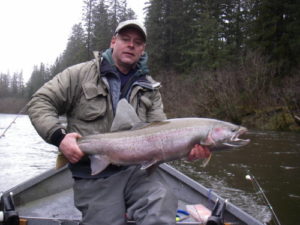
1. IT’S ALL IN THE DETAILS
The best steelheaders are well prepared and pay attention to the details. Preparation can start weeks, even months, ahead of an upcoming fishing trip, and I believe it is a good practice to give yourself plenty of time to do the things that will ensure everything runs as smoothly as possible.
I remember a phrase from the book The Art of War – written by the Chinese general Sun Tzu – that states “Every battle is won before it is fought.” I use that to help motivate me when I am getting ready for my next Alaskan adventure. I am not trying to depict steelheaders as warriors, nor am I about to compare fishing to combat (that would be ridiculous).
However, I know that the success of a trip can be contingent on how well you prepare for it, so I use that quote to help remind me that I need to be as thorough as possible.
An experienced fisherman understands that he can’t control the weather or how good the fishing will be. But there are actions that can be done that might swing the odds in his or her favor. The most important issue to be concerned with is the timing of the run, because you cannot catch something that isn’t there.
This is when you need to do some research so you can attempt to predict when the fish will be in the river. And even though you’re not dealing with an exact science, you can still follow some general, historical guidelines that will give you an indication of when would be the optimal time to schedule an outing.
Also, you will never see experienced steelheaders succumb to the extreme Alaskan weather, because they know how to prepare for any adverse situation the weather gods choose to throw at them. They expect to fish in the rain and will be equipped accordingly.
The best way to take on the elements is to bring extra sets of clothing so they can be rotated when a garment becomes saturated. This is significant because it’s impossible to do anything when you are uncomfortable.
If you start out wet, there is a pretty good chance you are destined to be miserable for the rest of the day. You’re going to be thinking about calling it quits rather than concentrating on fishing. Steelheaders know the importance of comfort and they refuse to let the adverse weather conditions keep them off the river.
I learned this early on in my steelheading tenure. I fished with a guy who brought just about two of everything on a trip, while I barely owned one of certain things. It rained for three days straight and I spent every night hanging my wet clothes anywhere and on anything I could find. I prayed that my stuff would dry in time.
On the other hand, my roommate smelled like fabric softener each morning because he had the resources to swap out his wet clothes for fresh ones each day. I was damp and cold throughout the entire week, which caused me to lose my focus and my catch rate reflected my misery.
There also are the things you have the power to control. It can be as simple as having all of your equipment in proper working condition: reels filled with fresh line, all the hooks in your arsenal checked and sharpened, and your raincoats and waders inspected for leaks.
You will never see an experienced steelheader lose a fish due to the line breaking or an equipment failure. It doesn’t happen because those kinds of mishaps can be avoided by paying attention to the little things before you make your first cast.
If you are traveling to a remote destination, use a checklist to help yourself remember to take all of the essential items that are impossible to replace. Alaska isn’t like the Lower 48, where you can run to the nearest store if you forget to bring something. As much as I enjoy visiting the Alaska Commercial Co. store every year, I don’t want to have to rely on it to replace a key piece of equipment.
Another reason why it helps to bring extra gear is because the airlines (bless those hard workers who handle my bags) will inadvertently lose a valuable piece of luggage now and again. It happened to me once, but since I had duplicates of everything that were divided into two separate bags, I was able to mix and match all of the items that I needed from the one duffle bag that did show up. I was able to fish my first day without missing a beat instead of having to sit on the sidelines and wait for Alaska Airlines to deliver the missing bag to my room.
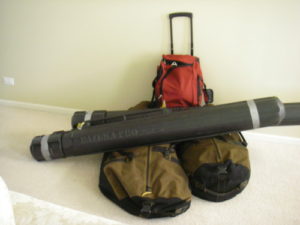

2. MAKING EVERY SECOND COUNT
Perfect steelheaders manage their time efficiently both on and off the water. There are certain activities where clock management is crucial, and fishing trips loosely fit that category. You only have X number of hours in a day and Y number of hours during the entire trip to fish, so doesn’t it make sense to be as efficient as possible?
I am always devising alternative ways to budget my time when I travel to Alaska. My philosophy is that I’m only going to be here for a few days, so I might as well fish as much as possible.
I feel that I can always rest when I get home. I’m not trying to imply that everyone needs to spend every moment of daylight on the water and fish like a robot to the point it stops being enjoyable.
I just think that you should be cognizant of how you manage your time throughout the day. This starts the moment you unpack your bags. Don’t unload your belongings into a disheveled mess to the degree that you can’t find anything.
Instead, implement a system that helps you remember where everything is and that it’s easily accessible. Don’t waste precious time each morning searching for an article of clothing or, worse, not be able to find a vital piece of equipment that you need on the river.
Any task that can be accomplished the night before should be taken care of then. Don’t put things off until the next day. This includes laying out your wardrobe, rigging your rods and fixing or replacing any gear that was lost or damaged while you were out fishing earlier that day.
Every evening, I will restock any lost terminal tackle as soon as I get back to my room. I know that I will probably forget something important if I wait until the next morning to replace it. Every minute that you can shave off in your room can be added to your time on the water.
Even something as simple as taking showers the night before instead of in the morning can save you valuable time. This is especially true when you are sharing a room with guys who don’t function very well as they wake up.
It can be time consuming to coordinate the bathroom schedule into everyone’s routine. I subscribe to the theory that the less things you have to do in the morning, the faster you will be headed to the river.
It is wise to maximize your productivity by keeping a bait in the water as much as possible. Good steelheaders know this and will make it a point to do so because it dramatically increases the chances of hooking up. I haven’t heard of too many people who have caught a fish while their lure is attached to the hook keeper.
When I was in high school, I used to do a lot of crowd fishing for salmon and steelhead on weekends. That way I was able to interact with a cross-section of fishermen. It was basically the same cast of characters every week and it became easy to see who consistently caught the most fish. The anglers who spent the most time fishing – not the guys standing around talking with their hands in their pockets – were the ones with the most fish on their stringers.
So I now apply this rudimentary principle whenever I can. If I am floating the river in a drift boat, I’ll make sure that there is someone standing up front and actively fishing at all times. While transitioning from one hole to another we have discovered several nondescript spots that held large numbers of fish.
Some of these obscure places turned out to be trip savers. I don’t mind if my partners are admiring the beauty of Alaska – I encourage that – but I just ask that they are covering the water while they are watching nature do its thing.
Another efficient way to conserve time is how you handle lunch breaks. I remember reading a book when I was in grade school about the great Wisconsin musky guides. The author asked one of the guides about what he likes to serve for his shore lunch. He said that he doesn’t believe in shore lunches because they are too time consuming. He used the example that if you guide a party for two days and spend about an hour and a half for lunch each day, you will lose approximately three hours of fishing time.
That philosophy still resonates with me. Think about the valuable time you would lose over the course of a week. You will sacrifice almost a full day’s worth of fishing time if you break it down that way. I tell my partners to take turns eating while we are moving.
I’m familiar with the streams I fish, so I have a pretty good idea where the best stretches are to break out the snacks. I prefer to eat while I’m rowing. I had to learn how to balance a sandwich on my thigh, which might not be the most enjoyable way to eat a meal, but it is an efficient alternative. Besides, if I’m looking for five-star dining, I wouldn’t expect it to be served out of a brown paper bag on a river.
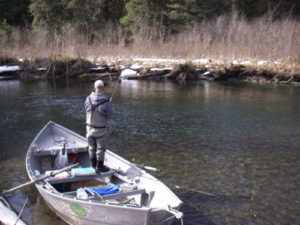
3. BRINGING YOUR ‘A’ GAME
Steelie anglers will fish at a high level from start to finish and will be the most persistent people on the river. This is something that I try to preach to anyone who fishes with me.
I have learned that you will only get a finite number of chances (bites) when you are fishing, so it’s imperative that you make the most out of your limited opportunities. This means being dialed in from your very first cast until you put away your rods in the vehicle.
It’s a poor excuse to miss a fish because you weren’t “ready.” One of my biggest steelhead that I have ever landed in Alaska was a massive fall-run male that weighed well over 20 pounds. It was hooked within the first minute of the first day of a trip. Talk about an icebreaker.
This happened so fast that I really don’t remember much of the fight, but I do recall that my buddy Danny Kozlow and I were ready from the moment we dropped the boat in. The fish was holding in the first hole that was located within 200 yards below the boat launch.
If Danny and I weren’t both on point that morning, we would have probably passed by that hole without dropping a bait through it. You never know when you’re going to encounter that fish of a lifetime, so you need to be at your best as soon as you step into the river.
Good steelheaders do everything with a purpose. They know that when things are going well you stick with it. When something stops working they won’t hesitate to search for something that does work.
It sounds like a no-brainer, but it’s surprising to see so many anglers refuse to follow this simple rule. For example, I have fished with a few guys who would get off to a hot start using a bobber and jig. For no apparent reason, they will pick up a spinner rod and start chucking hardware for the next three hours.
Why would anyone do that? Of course, there are anglers who only want to fish a certain way. They’ll refuse to make any necessary changes when the fishing slows down. These guys are content to grind out the day until whatever they are doing hopefully starts to work for them again.
Unfortunately, these are the same people who will inadvertently become the designated net man or the official trip photographer because they are unwilling to adapt to the changing conditions.
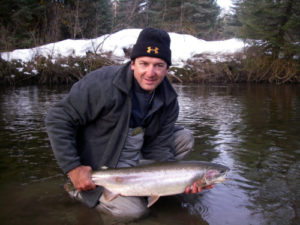
4. CHANGING ON THE FLY
Seasoned steelhead anglers are willing to adjust, even if things don’t make sense. The first time I stepped onto Alaskan soil, I already had almost 20 years of Midwestern steelheading under my belt.
I thought that I could catch these fish anywhere in the world (man, did I have a lot to learn). The reason why I chose Alaska over some of the fabled steelhead rivers of Oregon, Washington and British Columbia was because Alaska’s streams appeared to be similar to the Michigan rivers that I was accustomed to fishing.
When I saw the Situk River for the first time, I immediately knew that I had made the right decision. I expected the river to be the way it was, but what I didn’t predict was the fish to be so quirky.
It drove me insane when I saw groups of 25 or more fresh steelies holding in plain view on a shallow flat that was in close proximity to an 8-foot hole. I didn’t understand. Why they would sit out in the open when the perfect sanctuary was only 40 yards away?
It also took me years to accept that these big, dominant, ocean-run steelhead didn’t want anything to do with a moderately sized plug at certain times, but they would devour a mini-plug that’s slightly larger than an M&M.
I couldn’t fathom why my lures worked so well on steelhead that were half the size back at home, yet these native fish wanted nothing to do with them. It took me several years to finally give in and to admit that the Situk steelies have a unique personality. I needed to adapt my strategies to fit an Alaskan steelhead’s behavior.
Maybe a less experienced fisherman might believe that a steelhead is the same fish anywhere in the continent, but a veteran metalheader knows this isn’t always the case. Too many anglers feel that it’s unnecessary to adapt. They can still clobber the fish by using the same methods that work on their favorite rivers. Don’t get me wrong: Most steelheaders will do fairly well in Alaska, but the ones who are open-minded will usually end up being the top rods on the stream.
A good steelheader won’t assume anything, understanding that fish aren’t always where they should be. He will systematically dissect a run piece by piece until he locates the fish, and the reason why he is so meticulous is because he realizes that the fish won’t find him.
He will fish different sections of a run by changing where he stands and where he places the next cast. I’ve seen inexperienced anglers become complacent and only stand in one area and repeatedly cast to the same general spot, which results in the same drift. They only fish places where they believe the fish should be, instead of accepting the fact that the fish don’t always follow the rules.
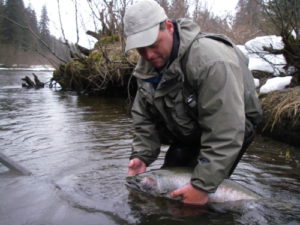
5. ANSWER THE QUESTIONS, PLEASE
Longtime steelheaders still ask questions and will always consider themselves students of the game. I believe that you don’t learn very much by talking, which is why I try to shut my mouth and listen.
When I am participating in a discussion with other steelheaders, I can always tell who the best fishermen are by the way the conversation flows. The ones who sit back and listen to what everyone else is saying will usually be the ones I see fighting the most fish on the river. They will be happy to share some information if confronted, but they would rather pay close attention to what the other anglers are divulging.
Guides are notorious for asking questions. They will say something like, “Hey; have you done much plugging this morning?” Or it might be, “Have you tried any dark-colored jigs today?” They will come off as being friendly, but they are not looking to make friends with anyone.
The intention here is to extract information that they can be of use in the future, and there is nothing wrong with that. It’s just another trick of the trade. As for me, I try not to ask any specific questions out of respect for other’s privacy, but I will be happy to listen to anything someone wants to reveal to me.
Last season while I was on the river, I met a couple of dudes from Anchorage who were having one of those days that all of us who fish dream about. They were elated about their good fortune and were more than willing to disclose all of the details, including where they were catching most of their fish.
I didn’t think it was right for them to disclose the location of their honey hole, but if they wanted to volunteer the information, then I was going to pay attention. They described the area in graphic detail. It was a deep, dark corner hole, surrounded by logs along the far bank that was supposedly stacked with chrome steelies a few bends upstream from where we were talking.
I knew the exact spot they were describing, having fished it before with marginal results. We were floating the river in drift boats, so it was impossible to go back there and fish it again that day. Now I was faced with a mental dilemma. Do I stop and fish “their” hole the next day if I am ahead of them? Or do I take a pass and leave it for those guys?
The problem was resolved when they told me that they had regrettably booked a halibut trip several weeks in advance that was scheduled for the following morning, and there was no way to back out of their obligation. Perfecto!
I don’t want to share all of the gaudy details, so let’s just say that little morsel of information worked out very well for me and my crew the next afternoon.
BOTTOM LINE, THESE ARE some of the factors that set apart the upper echelon of steelheaders from the rest of the community. None of these recommendations are earth-shattering, but you would be surprised how often that these simple concepts are overlooked.
Of course, nothing beats experience, but the only way to achieve that is by paying your dues. If you are looking to cut some time off the learning curve, then maybe some of these ideas will work out well for you! ASJ



